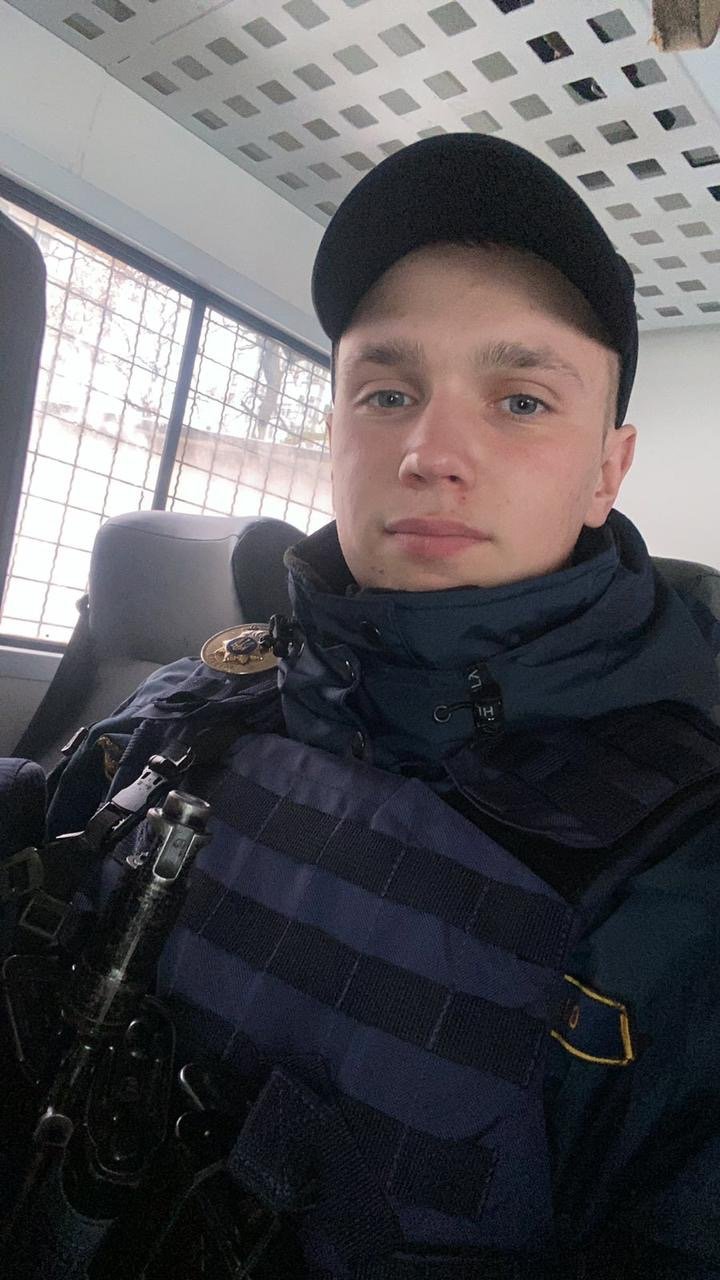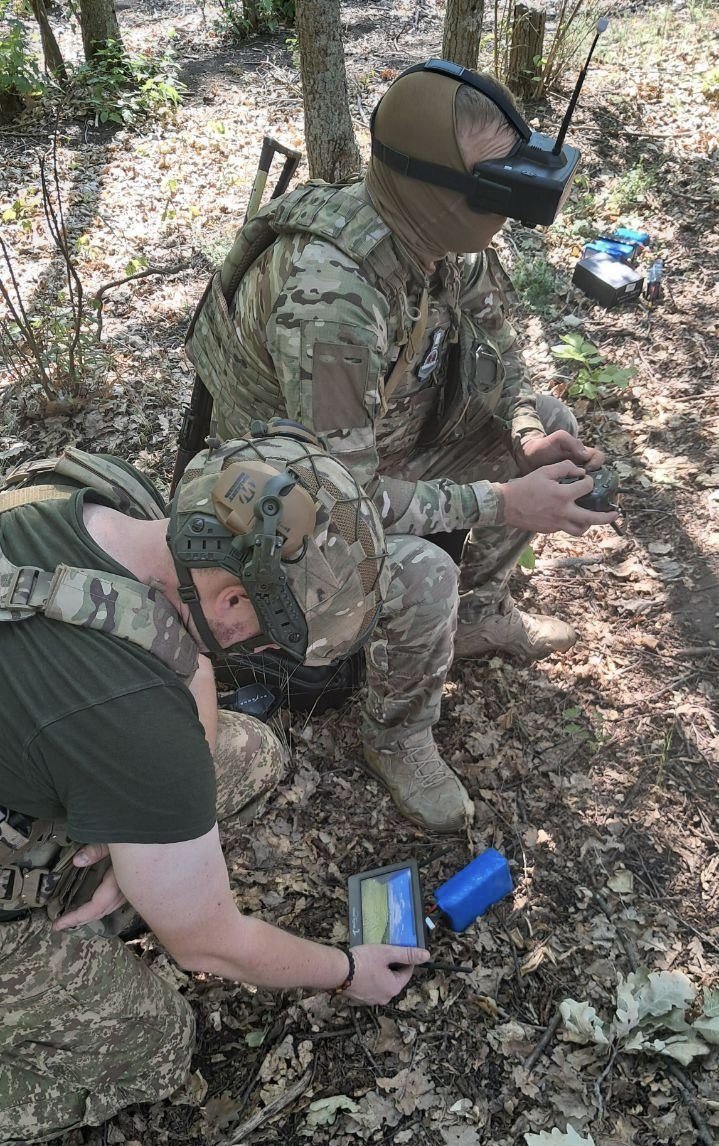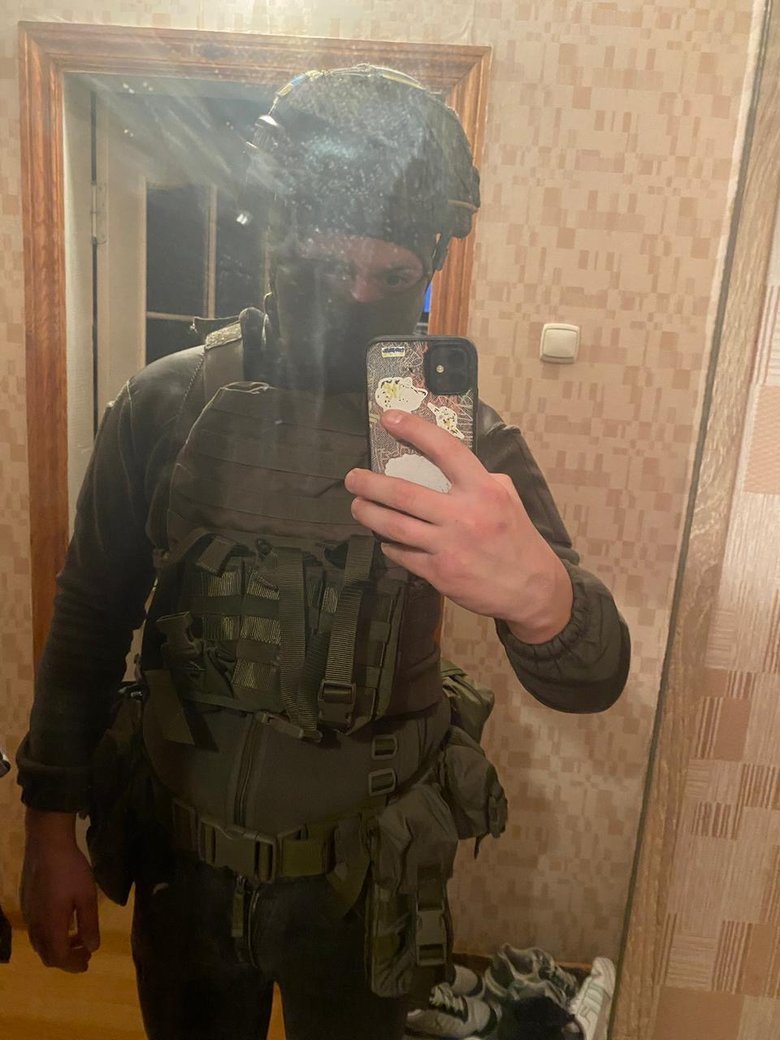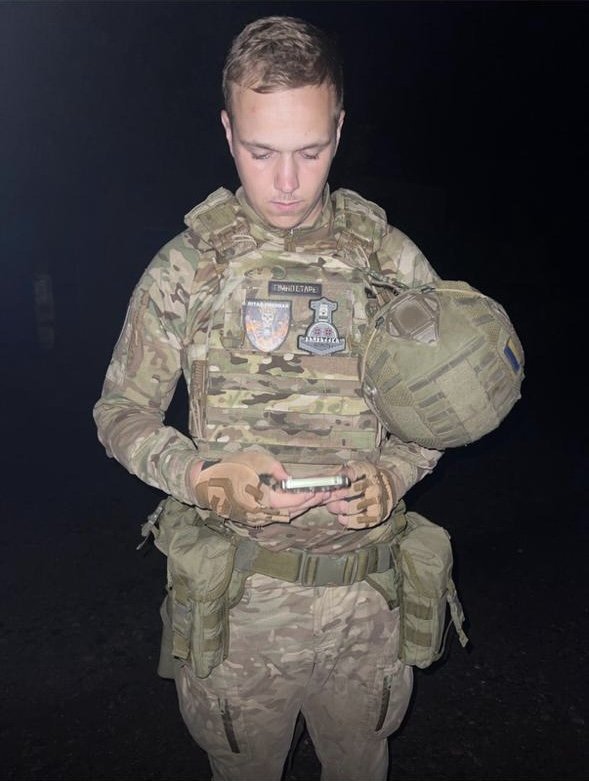Call sign Vovk: "Sometimes enemy doesn’t react to drone. You fly, and he either just looks or keeps walking."
Drone Industry
Today, Pavlo serves as an FPV drone operator with the 25th Brigade of the National Guard of Ukraine. In the military, he is known by the call sign Vovk (Wolf). He came up with it easily, recalling how he used to wear T-shirts with this animal as a child. His comrades sometimes jokingly call him "wolf cub," given his young age, he is 25 years old.
Before the full-scale invasion, he worked on construction sites, as a general laborer, electrician, and loader. He was involved in apartment demolition. On 24 February 2022, he happened to be at another job site.
- "We were asleep. We were supposed to get up for work in about an hour. And then we heard explosions," he recalls that night. "One of the guys says: ‘The war has started!’ Another replies: ‘It’s just thunder! Go back to sleep,’" (he smiles — O.M.). "But I knew it wasn’t thunder. We called the supervisor. He told us to pack up and go home. That’s what we did. Then we walked with our bags for about forty minutes to the Teremky metro station, because nothing was running, no buses, no minibuses."
- What did you see at that moment? What were you talking about?
- People around us were panicking, everyone was bustling about. We walked calmly, talking among ourselves: "How did this start? What will happen? How could it end?" We didn’t feel any anxiety or fear yet.
- Did you discuss the possibility that the Russians could reach Kyiv? At that time, there was such a threat.
- No, we didn’t discuss that. We didn’t have the full picture. We only heard that there were explosions somewhere. We assumed: probably war. Later, we read online that it was a full-scale invasion.
- You signed a contract and joined the National Guard, right?
- Yes. I spent a couple of days looking around the unit, and they sent me to a checkpoint. I stood there for about three to four months, with breaks and days off. We also went on patrol from time to time and maintained order at mass events.
- What happened next?
- I was sent to BMT (Basic Military Training — O.M.) in the Lviv region. It was standard pre-service special training.
After that, I served another two years at checkpoints and at mass events. Then my partner said to me: "Let’s transfer to the unmanned systems platoon, we’ll fly drones." I said: "Let’s do it! I want new experiences."
We immediately submitted transfer reports, which were approved literally within two days. We transferred and went to train as FPV pilots. We spent a month in training and received our certificates.
- Why FPV in particular? Usually, people start with a Mavic.
- I had already been sent for two weeks of Mavic flight training while I was still on checkpoint duty. The commander asked who wanted to go learn. I volunteered. I have that certificate as well. So I can fly both Mavic and FPV.
- FPV control is different from a Mavic.
- It is. That drone is harder to handle. Sometimes you pick up the controller, try to take off, and it just flips you over. With a Mavic, for example, you push the stick up and lift off smoothly, then simply adjust the direction. With FPV, it’s more complicated, you need to make specific micro-movements.
- Yes, FPV pilots have told me: "It’s almost jeweler’s work."
- Exactly! As I said, it’s micro-movements. You also have to calculate even the angle of approach to the target and how to strike it.
- Plus the goggles, they change perception and give a clearer picture, but they’re an additional strain.
- I used to always fly with goggles. But lately I try to work on a small screen so as not to damage my eyesight. It’s easier that way. When you put on the goggles, the picture is right in front of your eyes, and you see nothing else. Sometimes the connection drops or the image flickers, and that really strains the eyes. With the screen: you sit in the dugout, fly, and see the overall picture, and your eyes don’t get as tired.
- By the way, in an interview, a pilot from the "Drongo" group with the call sign Ara told me that his partner, who works with FPV, during long flights would have his goggles fill with tears from the strain.
- That hasn’t happened to me yet. But I really love flying. As soon as they say we need to take off and hit a target, I put on the goggles right away and go. Still, sometimes after a shift, you go to sleep, wake up, and your eyes burn so much you probably need to buy some eye drops and use them. I haven’t tried that yet, so I don’t know if it helps.
- How did you get to the front line?
- Our unit got a new commander. He asked: "Are you ready to work in the East?" We said yes. He briefed us, prepared us, and on January 6 this year we deployed to our current sector.
- What were those first days like?
- I don’t remember the first days well (he smiles — O.M.). We arrived in Sloviansk. They trained us a bit more in flying, tested what we could do, and assigned who would operate Mavics and who would handle FPVs. My comrade showed good results on the Mavic, so he was immediately taken into reconnaissance. About three days later, I was sent out to the position with FPV. The entry was interesting. We were dropped between two of our positions, each about 200 meters away. At first we headed the wrong way, toward our reconnaissance comrades. While we were walking, the vehicle that brought us came under fire. One mortar round landed about five meters from me. Luckily, it didn’t hit. We ran into a dugout. I checked myself for shrapnel, seemed fine. But five minutes later, my leg started burning. I looked, pants torn a little, and there was a small fragment. But only tangentially.
We waited about three or four hours. Then we asked the controller if the skies were clear, if we could move to the position. He confirmed, so we went. When we arrived, it turned out that the position we had first headed for had been spotted, the Russians had already targeted it with FPVs, Mavic drops, and mortars.
- How long did you stay there?
- Twelve days. I hardly stuck my head out. FPVs were tearing up the entrance, then they’d drop grenades, then the mortars would start. Our guys were flying, of course. But after that first shelling, I didn’t want to pop up and be KIA.
- And when did you finally fly?
- After the May rotation.
- What was your first combat sortie like?
- They said we needed to hit an enemy "den", their dugout or shelter. I set up the Mavic, with a repeater on it to steer the signal. I grab the controller and goggles, take off. First impression: I have to figure out where to fly (he smiles — O.M.). I lift the goggles, hover lightly, fly straight and look at the map: okay, this way. Got it! I put the goggles back on, pick out the tree lines I was using as reference, and head for the target. The video feed was breaking up, I didn’t have the range, but I had to make the run. The Mavic loiters overhead, watching and waiting. And my battery was already running low, I needed to bring it back. I steadied the view on my end, saw the dugout right in front of me and went straight into it. The blast—wow! I thought: whoah, it hits hard (smiles — O.M.).
- Great when it works right away!
- We’d had a lot of practice beforehand. So in combat, I went up calmly, without nerves, and struck the target.
- See how well it went for you! Some pilots admit their hands shook during their first combat flight.
- Didn’t happen to me. My hands only shook in training, when I had to pass the exam (he smiles — O.M.). Once I got into combat, I was used to the controller, everything familiar.
- I know you don’t want to fly the "Vampire." Why?
- I don’t. We had situations while setting up new, not-yet spotted positions. The Vampire was behind us, and we were a few houses ahead. It takes off and returns to the same spot, so both Mavics and FPVs can track it back. Then the enemy looks at the footage, the coordinates where the airframe landed, and starts hitting that area with mortars, tube artillery, and guided aerial bombs (KABs). We came under fire as well. So I don’t even want to learn to fly the Vampire (he smiles — O.M.).
- In that sense, FPV is indeed safer. Usually it’s a one-way drone: you fly, you hit, and that’s it.
- Sometimes I go up for reconnaissance without explosives. I just take a look where a Mavic can’t. Then I mustn’t bring the drone back, I’ll sink it in a pond somewhere or ram it into the bushes so it doesn’t interfere with my feed. Because if you bring it back, you often have to crank up the video power, and the enemy can pick that up, geolocate where you are, and find the position.
- What are you hitting most often now?
- Enemy manpower - infantry and drone pilots. Also, motorbikes and other light vehicles.
- On your axis, the enemy hasn’t used heavy armor for a long time. Now they try to advance with infantry groups, riding in on motorcycles, right?
- Right, motorcycles are actively used to deliver infantry. Sometimes two per bike. Two or three bikes roll up. They almost reach the line, drop off the guys riding pillion, and those move on toward our positions while the bikes head back. Thanks to us and our infantry, not all of them make it (he smiles — O.M.).
Those who dismounted make it only as far as the first house or a bush at best. Once I saw one of two literally sprint across a kilometer-wide field, in just a few minutes! A real record-setter! (he smiles — O.M.). The second managed maybe 200–300 meters. While I was taking aim at him, the first one managed to get away.
- Does it happen that the enemy doesn’t react to a drone at all?
- Yes, that happens quite often. You’re flying, and he either just looks at it or keeps walking. Even when I’m already next to him and about to hit, he couldn’t care less!
- Why do you think that is?
- Honestly, I don’t know. Sometimes he looks at my drone and just moves on. I catch up and kill him. And sometimes I hit, the Russian gets shredded by fragments, lies there, then gets up and moves on. Maybe they inject something, or take something.
- I hear the same stories from soldiers I know. They also say Russians often move without body armor or helmets. Sometimes they "get dressed" along the way, stripping gear off their previously killed comrades. Have you seen that?
- I have. Once, three of them were crossing a field toward a tree line. The Mavic spotted them. I set up an FPV and took off. I’m watching the feed, one is just in a T-shirt, trousers, and with a rifle. No helmet, no body armor. The two behind him had armor, packs, everything as it should be. They reached the tree line where one of theirs was already KIA. One of them took the body armor and helmet off him and put them on himself. There was a pipe under the road and all three crawled into it. By the time I got there, they were already hidden. So I started figuring out how to enter, to fly cleanly into that culvert. I searched for two or three minutes. Found it. I fly in, but there’s no detonation of the drone, no ammo cooking off—nothing! We’re watching the Mavic feed, and out the other end come not three but nine men. (he smiles — O.M.). We were stunned!
- It turns out that six of them were sitting inside.
- Sitting there, getting organized. It turned out the Mavic didn’t spot them at first. That’s how it happened. Then mortars, FPVs, and a Mavic with munition drops from our adjacent unit started hitting them. They were all eliminated.
- What other story stuck with you?
- When I hit an enemy on a motorcycle. They told me: "There’s motorcycle movement, you need to scramble." I set the drone up and took off. I searched. At first, there’s no one. Then the Mavic spotted them, standing under a tree. I had just flown along that road. They heard me, jumped on the bikes and rode off. I turned, flew low along the road and caught up to the rear rider. I drove the FPV straight into his back. I destroyed both the bike and the rider. He didn’t stand a chance.
- And what about the first one?
- He just rode on. I wouldn’t have caught up to him in time.
- How would you describe the current situation on your axis?
- Sorry, but it’s a full-on madhouse. The enemy couldn’t care less. They keep coming and coming! They try to flank and push into our rear. Every day, we see up to a hundred Russians on the screens. We eliminate some of them, of course, but they keep coming—nonstop! Along the same routes, too. Sometimes I launch and the controller says three are moving along the standard path. I say I’ll be on station in seven minutes. And they just walk calmly, no running, no hiding, like they’re out for a stroll.
There was another story: we spotted an enemy; I took off, and there was a single tree by the road where he hid. We started playing cat-and-mouse (he smiles — O.M.). I chased him around that tree for three or four minutes until he stopped and shot my drone down with his rifle. Guess he got tired of running.
- Did you try to take him out with another drone?
- I did. I put up a second airframe and launched, but he had already disappeared from that spot. I searched, but couldn’t find him.
- Guys from the Rubizh brigade, who also fight on your axis, say the Russians deploy 40–50 FPV drones a day. That’s a serious fire effect. What numbers do you see?
- We don’t keep precise counts, but judging by the noise and the feed, roughly twenty drones a day for sure. Sometimes we sit in the dugout, hear the sound, an enemy FPV is approaching. It begins to search, finds something and strikes. For example, our neighbors had a very high antenna. An FPV spotted it at night and then started striking. That day up to ten FPV drones hit our grid square.
- What drones do they launch more often: reconnaissance or strike?
- It's hard to say. They use both Mavics and FPVs. Besides that, they have plenty of "wings", both strike and reconnaissance. Those are heard more often. Just now I flew and saw two or three wings over every field. We have guys working at high altitudes who take down both them and the Shaheds.
- Do many Shaheds fly in your area?
- Lately, over five or six days while I was on position, I only heard two Shaheds at night, that’s all. But the guys said that during those two days one hit one of our neighboring positions.
- And there are still quite a few fiber-optic drones…
- Yes, they use them widely now. When they spot a target, they take off and engage, since the fiber-optic feed is very stable and only fails if the fiber is severed. They also use such drones as "waiters" on the roads, to hit our vehicles delivering logistics and troops. Sometimes they plant two or three of these waiters on the road every 100 meters and just wait.
- Fortunately, Russians don’t always handle them well, they can’t always take off or strike properly.
- Five or six of those drones may approach, but only one lands correctly. The others blow up. Yesterday (31 August — O.M.), before leaving the position, I flew over and checked the road our "box" drives on. I found four fiber-optic "waiters" set up every 100 meters. I even destroyed one of them.
- The Russians don’t seem to have supply issues on your axis, do they?
- Definitely not. Their pilots can sit far away. They just use a more powerful battery and a light payload. The fiber stretches for 15–20 kilometers. I haven’t seen more than that.
- How are they doing with electronic warfare?
- Lately, they’ve started jamming us hard. We used to fly freely toward where the enemy was, the picture was stable. Now their EW starts operating there. We sometimes lose drones because control drops out and they fall. We managed to recover about 30 percent.
- Have you taken part in "air-to-air" fights—drones versus drones?
- That’s usually a Mavic against their Mavic or an FPV. I personally haven’t been in that kind of duel. But I’ll tell you a story. One of our guys was running a Mavic carrying a repeater, and I was flying FPV. I’d flown out about 300–400 meters when I lost my airframe after an enemy FPV hit our Mavic. It shattered. The antenna that was sustaining the FPV link did too. So we lost two drones at once. After that, we had one Mavic 3 left. We worked with it until they brought a Mavic 4. You can’t fly those too often with a payload.
- One more question: what do you think about talks on a possible end to the war?
- What talks can there be when the enemy is pressing and up to a hundred men attack here every day?! Like I said, they keep coming! Under those circumstances, it’s hard to believe there’ll even be a ceasefire.
- Some soldiers predict the war could drag on for years. How long are you prepared to stay?
- I plan to stay as long as I can fight and help. My health allows it. That’s the key factor. If you can take it, you keep working. If serious problems start, say with your back, so you can’t even wear body armor, you have to deal with them.
- Physical condition is a very important factor. People often say younger guys are more effective fighters than those forty-plus…
- You know, not always. Sometimes the older ones give the youngsters a run for their money (he smiles — O.M.).
- In that context, I’ll recall the Cabinet’s decision allowing men aged 18–22 to leave Ukraine freely during martial law. I’ve heard from your colleagues that this could lead to an outflow of youth who might otherwise take up arms and defend the country. What do you think?
- Honestly, it all depends on individual willingness. Whoever wants to go to war will go. Whoever is afraid will either go abroad or hole up at home like a mouse and hide. Those who want to and can will fight at the front, or protect the cities, like our 25th Brigade of the National Guard of Ukraine in Kyiv, for example. The key, I repeat, is the will, plus motivation and a clear understanding of where you’re headed.
- Tell me, what do you dream about?
- To go to Kyiv, get some rest, and see my loved ones. And once you deploy to the positions, the only thoughts are how to kill the enemy and how to make this end sooner. In general, I want to keep planning my life, either stay with the unit and move up the ranks, or continue in my specialty and start a family.
But as long as the war goes on, I’m here.
Olha Moskaliuk, Censor.NET
Photos provided by the interviewee.







